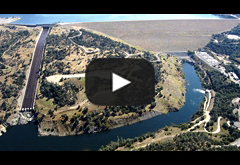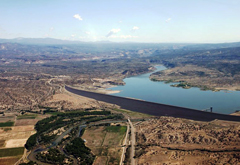11. Gardiner Dam:

The Gardiner Dam on the South Saskatchewan River in Saskatchewan is the third largest embankment dam in Canada and one of the largest embankment dams in the world. Construction on Gardiner Dam and the smaller Qu'Appelle River Dam was started in 1959 and completed in 1967, creating Lake Diefenbaker upstream and diverting a considerable portion of the South Saskatchewan's flow into the Qu'Appelle River. The dam rises 64 metres in height, is almost 5 km long and has a width of 1.5 km at its base with a volume of 65,000,000 cubic meters. More details
12. Oroville Dam:
13. San Luis Dam:

San Luis Dam is a dam that creates San Luis Reservoir, which serves as an off-stream reservoir for the California State Water Project and the Central Valley Project. It is also known as the B.F. Sisk Dam, after Bernie Sisk. The earth-fill gravity embankment dam is 305 feet (93 m) tall and was completed in 1967. It is located between Los Banos, California and Gilroy, California, United States along Pacheco Pass. The plant's eight Francis turbines produce a combined 424 MW. More details
14. Nurek Dam:
The Nurek Dam is an earth fill embankment dam on the Vakhsh River in the central Asian nation of Tajikistan. Construction of the dam began in 1961 and was completed in 1980, when Tajikistan was still a republic within the Soviet Union. At 300 m (984 ft) it is currently the tallest man-made dam in the world. A total of nine hydroelectric Francis turbines are installed in the Nurek Dam. Originally having a generating capacity of 305 megawatts each (2.745 gigawatts total), they have since been redesigned and retrofitted such that they now combine to produce 3.015 gigawatts. More details
15. Zhiguli Dam:
Zhiguli Dam is a large dam and hydroelectric station on the Volga River, located near Zhigulyovsk and Tolyatti in Samara Oblast of Russia. It is the sixth stage of the Volga-Kama Cascade of dams, and the second of them by installed power. The dam is 2800 m long, 750 m wide and 52 m high and the installed power is 2315 MW. More details
16. Garrison Dam:
17. Cochiti Dam:
18. Aswan High Dam:

The Gardiner Dam on the South Saskatchewan River in Saskatchewan is the third largest embankment dam in Canada and one of the largest embankment dams in the world. Construction on Gardiner Dam and the smaller Qu'Appelle River Dam was started in 1959 and completed in 1967, creating Lake Diefenbaker upstream and diverting a considerable portion of the South Saskatchewan's flow into the Qu'Appelle River. The dam rises 64 metres in height, is almost 5 km long and has a width of 1.5 km at its base with a volume of 65,000,000 cubic meters. More details
12. Oroville Dam:
Oroville Dam is an earthfill embankment dam on the Feather River east of the city of Oroville, California in the United States. At 770 feet (230 m) high, it is the tallest dam in the U.S. and serves mainly for water supply, hydroelectricity generation and flood control. The dam impounds Lake Oroville, the second largest man-made lake in the state of California, capable of storing more than 3.5 million acre-feet (4.4 km3), and is located in the Sierra Nevada foothills east of the Sacramento Valley. More details
13. San Luis Dam:

San Luis Dam is a dam that creates San Luis Reservoir, which serves as an off-stream reservoir for the California State Water Project and the Central Valley Project. It is also known as the B.F. Sisk Dam, after Bernie Sisk. The earth-fill gravity embankment dam is 305 feet (93 m) tall and was completed in 1967. It is located between Los Banos, California and Gilroy, California, United States along Pacheco Pass. The plant's eight Francis turbines produce a combined 424 MW. More details
14. Nurek Dam:
15. Zhiguli Dam:
Zhiguli Dam is a large dam and hydroelectric station on the Volga River, located near Zhigulyovsk and Tolyatti in Samara Oblast of Russia. It is the sixth stage of the Volga-Kama Cascade of dams, and the second of them by installed power. The dam is 2800 m long, 750 m wide and 52 m high and the installed power is 2315 MW. More details
16. Garrison Dam:
Garrison Dam is an earth-fill embankment dam on the Missouri River in central North Dakota. At over two miles (3 km) in length, constructed by the U.S. Army Corps of Engineers from 1947-53. The reservoir impounded by the dam is Lake Sakakawea, which extends to Williston and the confluence with the Yellowstone River, near the Montana border. Hydropower turbines at Garrison Dam have an electric power generating nameplate capacity of 583.3 megawatts. Average production of 240 megawatts serves several hundred thousand customers. More details
17. Cochiti Dam:
The Cochiti Dam is an earthen fill dam located on the Rio Grande in Sandoval County, New Mexico. Cochiti Dam is one of the four United States Army Corps of Engineers projects for flood and sediment control on the Rio Grande system, operating in conjunction with Abiquiu Dam, Galisteo Dam and Jemez Canyon Dam. Cochiti Dam is primarily a flood control dam built to ameliorate the effects of heavy run off. The dam and the resultant lake also had the secondary purposes of creating recreational and wildlife habitat resources. The outlet works of the dam are capable of 14,790 feet3/s (418.8 m3/s) of outflow. More details
18. Aswan High Dam:
Aswan High Dam is an embankment dam situated across the Nile River in Aswan, Egypt. Since the 1950s, the name commonly refers to the High Dam. Construction of the High Dam became a key objective of the Egyptian Government following the Egyptian Revolution of 1952, as the ability to control floods, provide water for irrigation, and generate hydroelectricity were seen as pivotal to Egypt's industrialization. The High Dam was constructed between 1960 and 1970, and had a significant impact on the economy and culture of Egypt. More details
19. W.A.C. Bennett Dam:
The W. A. C. Bennett Dam is a large hydroelectric dam on the Peace River in northern British Columbia, Canada. At 183 m (660 ft) high, it is one of the world’s highest earth fill dams. Construction of the dam began in 1961 and culminated in 1968. At the dam, the Finlay, the Parsnip and the Peace Rivers feed into Williston Lake, also referred to as Williston Reservoir. It is the third largest artificial lake in North America (after the Smallwood Reservoir and Manicouagan) as well as the largest body of fresh water in British Columbia. Williston Lake runs 250 kilometers north-south and 150 kilometers east-west. More details
20. Afsluitdijk Dam:
20. Afsluitdijk Dam:
The Afsluitdijk Dam is a major causeway in the Netherlands, constructed between 1927 and 1933 and running from Den Oever on Wieringen in North Holland province, to the village of Zurich in Friesland province, over a length of 32 kilometres and a width of 90 m, at an initial height of 7.25 m above sea-level. More details






